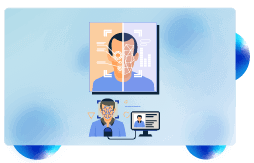Artificial intelligence (AI) is swiftly reshaping our reality, sparking innovation across diverse domains. Yet, amid this advancement lies a pressing issue: deepfakes. These ultra-authentic synthetic media pieces can alter videos or audio to fabricate instances where individuals seem to say or do things they never actually did.
The ‘2023 State of Deepfakes Report’ by ‘Home Security Heroes,’ a US web security services company, reveals a staggering five-fold surge in deepfake videos since 2019. This exponential growth trend has seen the volume of deepfake content online double every six months in recent years.
This blog aims to navigate the realm of deepfakes, examining their mechanics, the inherent risks they carry, and crucially, strategies to shield oneself from succumbing to their deceit.
What Are Deepfakes and How Do They Operate?
Deepfakes harness the capabilities of deep learning, a subset of AI, to craft remarkably persuasive counterfeits. They commonly employ two deep learning methodologies:
- Autoencoders: These algorithms discern the fundamental traits and features of an individual’s face or voice from extensive datasets of images or audio clips.
- Generative Adversarial Networks (GANs): This setup involves a duel between two neural networks. One network (the generator) endeavors to produce authentic counterfeits, while the other (the discriminator) strives to spot the fabrications. This ongoing rivalry enhances the generator’s capacity to generate highly convincing deepfakes.
Through the amalgamation of these techniques, deepfakes seamlessly blend source material with the visage or voice of a chosen individual, crafting a simulation that suggests they are engaged in actions or utterances entirely contrived.
The Potential Dangers of Deepfakes
Deepfakes pose a significant threat in several ways:
- Reputation Management: Deepfakes wield the power to tarnish the reputations of individuals or entities by disseminating false narratives or deceptive content. Product managers must assess how their offerings might be exploited by malevolent parties to fabricate deepfakes, taking proactive steps to mitigate such risks.
- Security Vulnerabilities: The advent of deepfake technology introduces fresh security vulnerabilities ripe for exploitation by cybercriminals seeking to circumvent defenses or access sensitive data illicitly. Compliance managers need to collaborate closely with IT and security teams to identify and address potential vulnerabilities, implementing robust safeguards against deepfake-related security breaches.
- Legal and Ethical Considerations: Deepfakes raise intricate legal and ethical dilemmas, encompassing issues like consent, defamation, and intellectual property rights. Compliance managers bear the responsibility of ensuring that their organization’s practices regarding the creation and dissemination of deepfake content adhere to pertinent laws and ethical standards.
- Financial loss: Deepfakes can cause financial losses in several ways, including through fraudulent transactions, manipulation of financial markets, and damaging reputations leading to lost revenue. They can be used to impersonate CEOs in video or audio clips to authorize fraudulent wire transfers or to trick employees into disclosing sensitive financial information. In the stock market, deepfakes could manipulate stock prices by spreading false information about companies. Additionally, when used to harm reputations, these can lead to a decrease in consumer trust and confidence, affecting sales and partnerships.
Protecting Yourself from Deepfakes
Despite the growing sophistication of deepfakes, there are proactive measures you can adopt to shield yourself from their manipulation:
- Source Verification: Scrutinize the authenticity of videos or audio clips by tracing their origins. Was the content shared by a credible source? Look out for discrepancies in editing or audio quality.
- Detection of Manipulation: Pay attention to subtle cues such as facial expressions and body language in videos. Do movements seem unnatural or out of sync with the audio? Are there any noticeable glitches or inconsistencies in the background?
- Reverse Image Search: Utilize tools like Google Images to ascertain the original source of images or videos, aiding in the identification of potential alterations.
- Fact-Checking Resources: Leverage platforms dedicated to debunking misinformation. If you encounter dubious content, cross-reference it with these resources to verify its accuracy.
- Stay Informed: Remain abreast of the latest developments in deepfake technology. Enhancing your understanding of their mechanisms empowers you to better recognize and counteract their influence.
Preventing Deepfakes in User Onboarding
Deepfakes can be a particular concern during user onboarding, where fraudsters might try to impersonate someone to gain access to an account or service. Here are some strategies to prevent deepfakes during user onboarding:
- Document Verification: Don’t rely solely on self-reported information. Verify government-issued IDs like passports or driver’s licenses to ensure the user’s identity matches what they claim. IDcentral’s Government Database Check uses AI techniques like optical character recognition (OCR) and APIs to cross-verify authenticity with details stored in millions of government databases. It validates identities within seconds, greatly accelerating approvals or rejection of requests.
- Biometric Verification: Utilize fingerprint scanners, facial recognition, or iris scans to confirm the user’s physical presence. These methods are difficult to forge with deepfakes. IDcentral uses precision AI/ML based technology to enhance accuracy by up to 99.9% in extracting and verifying fingerprint data.
- Liveness Detection: Utilize techniques like blinking, head movement, or holding up fingers to ensure a real person is behind the device, not a pre-recorded video. IDcentral’s Liveness Detection solution, renowned for its advanced accuracy, swiftly distinguishes live users from fraudulent ones using biometric data. Offering both active and passive liveness detection, businesses can choose the method that suits their needs best. Our product accurately detects liveness in both modes, enhancing security and preventing fraud while elevating customer experience.
- Deepfake Detection Tools: Integrate AI-powered solutions specifically designed to identify deepfakes during onboarding. These tools analyze facial features, lip movements, and other visual cues to detect inconsistencies.
- Multi-Factor Authentication (MFA): Require users to provide a second verification factor, such as a code sent to their phone or email, to gain access after providing their credentials. This adds an extra layer of security.
- Risk-Based Verification: Implement a system that assesses the risk associated with each onboarding process. High-risk scenarios might warrant stricter verification procedures like video calls or in-person verification.
- Face Matching Online: Validate the authenticity of customers by comparing their images to government IDs and databases. IDcentral’s Face Match Solution uses unique facial features for identity verification, penetrating visual distractions like facial hair or masks to eliminate fraud by 70% with Face Biometrics. The technology also incorporates advanced age mapping techniques to consider age differences when authenticating customers.
The Future Trajectory of Deepfakes
Deepfakes represent an ever-evolving technological landscape. As artificial intelligence continues its advancement, the prospect of even more convincing and elusive deepfakes looms on the horizon. However, parallel to this progression, there emerges a burgeoning effort to devise mechanisms for deepfake detection. Researchers are actively engaged in refining algorithms capable of discerning subtle discrepancies within deepfakes, such as nuanced alterations in facial expressions or speech cadence.
Navigating Forward
- Recent findings reveal a 704% increase in “face swap” deepfake attacks on ID verification systems in 2023, according to iProov‘s 2024 Threat Intelligence Report. The surge is attributed to the widespread availability and affordability of generative AI tools, facilitating the creation of convincing false identities.
- Technologies such as free or inexpensive face swap applications, virtual cameras, and mobile emulators have bolstered cyber attackers’ capabilities, posing new challenges for identity verification.
- Onfido, an ID verification firm, documented a 3,000% increase in deepfake fraud attempts in 2023, driven by the accessibility of low-cost generative AI tools. Fraudsters utilize these tools to create “cheapfakes,” basic yet effective alterations overlaying one face onto another, for breaching facial verification systems or conducting fraudulent transactions.
- The Indian government is preparing comprehensive regulations to address the rising threat of deepfakes, announced by the Ministry of Electronics and Information Technology (MeitY). The regulations will focus on four key areas: detection, prevention, establishment of a grievance and reporting mechanism, and raising public awareness about deepfakes. This initiative is part of broader efforts to curb the spread of hyper-realistic fake videos and audio, aiming to protect individuals and society from potential harm. (Business Today)
As the development and use of AI in generating convincing deepfakes continue to evolve, they pose a formidable challenge to identity verification systems. To effectively combat these evolving threats, businesses and security professionals must embrace more sophisticated verification technologies and strategies. Elevate your business’s defenses with IDcentral’s state-of-the-art AI-powered customer onboarding API solutions today!
Unlock AI-Powered Onboarding SolutionsRequest a demo

Mohini Sahu is a Digital & Content Marketing Executive at IDcentral (A Subex Company). She specializes in crafting engaging content on KYC and Onboarding Technology. With a thorough understanding of diverse industries, she creates insightful content on emerging trends and best practices.
